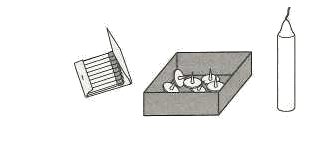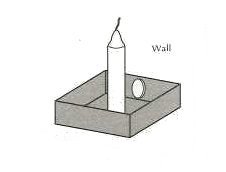
Given a book of matches, a box of thumbtacks, and a candle, how can you fix the candle to the wall so that its wax won’t drip onto the table below?
|
SelectClick for Answer |

Pin the box to the wall, put the candle in the box, and light it.
In experiments, Gestalt psychologist Karl Duncker found that most subjects instead tried to pin the candle directly to the wall or to use melted wax to affix it there (neither worked). Duncker called this “functional fixedness” — a “mental block against using an object in a new way that is required to solve a problem.” In this case, subjects had “fixated” on the box’s function as a container, which prevented them from considering it as a platform. If the box was empty at the start of the experiment, they were more likely to find the correct solution.
In a 2000 study, psychologists Tim German and Margaret Defeyter found the 6- and 7-year-olds show signs of functional fixedness, but 5-year-olds appear immune to it: “Rather than taking into account only the proper function of an object, they adopt an agents-goals view of function in which any intentional use of an object can be its function.”
|

